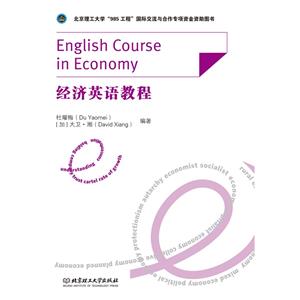-
>
豫商发展史与豫商案例研究:商圣范蠡评传
-
>
图解资本论
-
>
金融炼金术(专业珍藏版)2021专业审订
-
>
博雅丛书系列——经济行为的人文向度
-
>
新兴七国比较研究:全球化与国家竞争
-
>
协同创新网络研究
-
>
结构性改革:中国经济的问题与对策
经济英语教程 版权信息
- ISBN:9787564067632
- 条形码:9787564067632 ; 978-7-5640-6763-2
- 装帧:一般胶版纸
- 册数:暂无
- 重量:暂无
- 所属分类:>
经济英语教程 本书特色
《经济英语教程》(作者杜耀梅、大卫·湘)在编写中考虑到实际教学的需要,教师可根据学生的层次有选择地讲授某些内容。全书分为12个主题单元。每个单元分为3个模块:经济热点话题、思考驿站和补充阅读。这12个经济热点话题分别为:经济发展中的矛盾、教育公平、农民工问题、花钱与存钱、循环经济、奥运经济、交通与经济、福利与经济、信息产业与经济、道德信用与国力强盛、生活的富足与生命的丰盛和文化与经济发展。
经济英语教程 内容简介
《经济英语教程》分为12个主题单元。每个单元分为3个模块:经济热点话题、思考驿站和补充阅读。这12个经济热点话题分别为:经济发展中的矛盾、教育公平、农民工问题、花钱与存钱、循环经济、奥运经济、交通与经济、福利与经济、信息产业与经济、道德信用与国力强盛、生活的富足与生命的丰盛和文化与经济发展。针对《经济英语教程》的特点,在每个单元的第二模块“思考驿站”中编者选用一篇行笔优美、耐人寻味的文章供读者去思索和练习翻译。同时,针对学有余力的读者和学生,编者在第三模块设计了补充阅读,话题与主题单元相呼应,便于读者和学生更全面地了解和分析问题。在附录里还提供有各单元的参考答案和经济学的常用术语,便于读者参阅和查考。
经济英语教程 目录
Theme Topic:经济发展中中国面临的矛盾
Contemplation Garden:幸福的矛盾感
Supplementary Reading:新世纪的中国强大、富有、昌盛
Chapter 2
Theme Topic:中国的教育公平
Contemplation Garden:生命之重
Supplementary Reading:大学教育不是免费午餐
Chapter 3
Theme Topic:平等对待农民工
Contemplation Garden:繁忙的重要性
Supplementary Reading:农业、农村和农民
Chapter 4
Theme Topic:花钱还是存钱?
Contemplation Garden:生命不能承受之轻
Supplementary Reading:生存与住房
Chapter 5
Theme Topic:循环经济
Contemplation Garden生活中之两极
Supplementary Reading:环境与经济的和谐发展
Chapter 6
Theme Topic:北京的奥运经济
Contemplation Garden:人生的五个球
Supplementary Reading:美丽的中国印
Cbapter 7
Theme Topic:中国的交通与经济
Contemplation Garden:这个时代的隽语
Supplementary Reading:全球化与中国的交通系统
Chapter 8
Theme Topic:中国的福利与经济
Contemplation Garden:如果世界是个100人的村庄
Supplementary Reading:建立完善的社保体制
……
Chapter 9
Chapter 10
Chapter 11
Chapter 12
参考答案
经济英语教程 节选
Abiding by the “rules of the games.”China is gaining a reputation in theinternational business community, as a highly risky place to invest.Legal reforms,especially regarding intellectual property, will have to be made.Similarly corruptionhas to be dealt with.Here is where the intemational community can perhaps exert itsgreatest leverage.Providing the capital and expertise that China will need to continueto grow can be linked to China's compliance with international rules and regulations.Protecting the environment.China already produces 11% of the world'sgreenhouse gas emissions.Buming all that coal and oil without pollution protection orefficiency improvements, combined with the expected effects of growing road traffic,could have drastic effects on the environment. Feeding itself.China has 22% of the world's population, but only 7% of itsarable land.Degradation of land and shortages of water have become increasinglycritical.Pessimists include the Worldwatch Institute's Lester Brown, who projectsgrain imports exceeding 200 million metric tons by 2030.But China's own economistsare optimistic, expecting technological innovation to maintain a high level of self-sufficiency. Holding the social fabric together.High economic growth has covered up thestrain so far, but slower growth could create lots of unemployment and exacerbate thegrowing disparities between the flourishing coastal areas and the largely rural and lesswell-to-do interior.Also important will be the economy's ability to create high-leveljobs for the growing number of college graduates.Failure to do so could ignite studentactivism. China's economy and international policy.The response of the internationalcommunity to China's economic development hinges largely on whether the world canor will absorb the flood of exports that a fast-growing Chinese economy is likely toproduce.On the positive side, China has been open to imports, running a trade deficitsince reforms began in 1978.An open, thriving Chinese economy offers new marketsthat offset the threat that its exports present.In any case, China's economic growthwill give the international community great opportunities for leverage. Three possible scenarios for China's economic future are outlined by Dwight H.Perkins of the Harvard Institute for International Development: Scenario 1:The High Growth Alternative.Almost everything has to go right forgrowth to continue at 8% or 9% annually.The market orientation of the economystrengthens, and reform continues.State-owned enterprises are reformed, andcorruption is curbed.Sufficient capital is available.China's high rate of personal savings continues.The needed upgrades in the transportation and energy infrastructures are helped along by direct foreign investment.The quality of education improves, and more efforts are made to lure back home Chinese nationals studying or workingabroad.The global economy is willing to absorb a high level of exports from China'slabor-intensive manufacturing, based in part on China's liberalization of its importpolicies. Scenario 2:A Deteriorating External Environment.A Iess-favorable external environment combines with stalled domestic reform.The most likely trigger is whetherChina's rapid export growth leads to a protectionist reaction.The global economy isunwilling to absorb China's export assault, especially since the world sees China askeeping its own markets relatively closed.Another possible trigger is a mishandling ofthe Hong Kong transition.The result is that China's domestic economy is unable toabsorb its productive capacity and growth slows.As a result of economic trouble,reform stalls even reverses.Social unrest follows, further retarding economicliberalization. Scenario 3:Prospects for China.The consensus of the experts contributing to“China” in the 21st “Century”is that China will continue to grow rapidly if it dealssuccessfully with its internal issues and if the external environment is favorable.China's growth will slow down if either is unfavorable, but this will only delay itsemergence as the world's largest economy. ……
- >
巴金-再思录
巴金-再思录
¥19.8¥46.0 - >
推拿
推拿
¥12.2¥32.0 - >
中国人在乌苏里边疆区:历史与人类学概述
中国人在乌苏里边疆区:历史与人类学概述
¥37.1¥48.0 - >
史学评论
史学评论
¥18.5¥42.0 - >
龙榆生:词曲概论/大家小书
龙榆生:词曲概论/大家小书
¥9.1¥24.0 - >
罗曼·罗兰读书随笔-精装
罗曼·罗兰读书随笔-精装
¥40.6¥58.0 - >
经典常谈
经典常谈
¥25.9¥39.8 - >
中国历史的瞬间
中国历史的瞬间
¥23.5¥38.0
-
金融炼金术(专业珍藏版)2021专业审订
¥39.6¥55 -
韦伯--经济与社会
¥8.8¥17.9 -
新石油战争:一场重塑世界能源格局的战争
¥15.7¥49 -
国富论
¥14.6¥34 -
国富论彩图馆
¥15.1¥39.8 -
王亚南文选(全三卷)
¥64.5¥150















